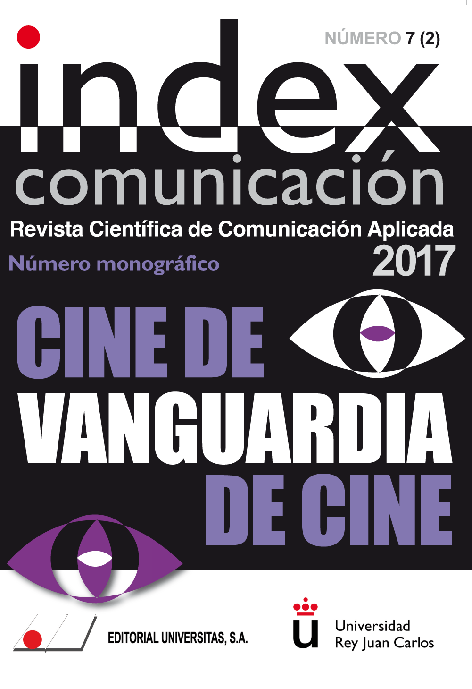Jean Cocteau in front of the Mirror of Orfeo
Keywords:
Cocteau, symbol, Surrealism, Orfeo, Avant-gardesAbstract
This article will identify the symbolic elements present in The blood of a poet with the myth of Orpheus, anticipating how this avant-garde film prefigured the poetic universe that Jean Cocteau would develop throughout his career. The formation of the imaginary of Cocteau was marked from his childhood by the traumatic death of his father that his mother wanted to compensate overprotecting him. Through the symbology present in his first film we will establish analogies and relationships between the author’s own biography, references to the myth of Orpheus and the interpretation that other artists close to surrealism made of these elements.
Metrics
References
ALEMANY, V. (2003). Arte del Siglo XX. Apuntes al principio de un siglo. Madrid: Dykinson.
ARAGÓN, L. (2016). El aldeano de París. Madrid: Errata Naturae.
ARNAUD, C. (2016). Jean Cocteau: A life (Lauren Elkin y Charlotte Mandell, trad.). New Haven and London: Yale University Press. (Obra original publicada en 2003).
BAUDELAIRE, C. (1994): El pintor de la vida moderna y otros escritos. Murcia: Colegio de Aparejadores y Arquitectos Técnicos.
BAUDELAIRE, C. (2003). Obra poética completa. Ed. de Enrique López Castellón. Madrid: Akal.
BENJAMIN, W. (2005). Moda. Capítulo B del Libro de los pasajes. Madrid: Akal.
CIRLOT, J.E. (1997). Diccionario de símbolos. Barcelona: Siruela.
DELEUZE, G. (2001): La imagen-tiempo. Estudios sobre cine 2. Barcelona: Paidós.
EINSTEIN, C. (2002): La escultura negra y otros escritos. Barcelona: Gustavo Gili.
EISENSTEIN, S.M. (2001). Montaje y arquitectura en Hacia una teoría del montaje. Volumen 1. Barcelona: Paidós.
FUENTES, V. (2000). Los mundos de Buñuel. Madrid: Akal.
HEGEL, G.W.F. (2007): La forma artística clásica y La forma artística romántica en Lecciones sobre la estética. Madrid: Cátedra.
LEOPARDI, G. (2013): Diálogo de la moda y la muerte. Madrid: Taurus.
LEVI-STRAUSS, C. (1995): El desdoblamiento de la representación en el arte de Asia y América en Antropología Estructural. Barcelona: Paidós.
MARCADÉ, B. (2008). Marcel Duchamp. La vida a crédito. (Laura Fólica, trad.). Buenos Aires: Libros del Zorzal.
RODIN, A. (1921). Les cathédrales de Francia, novena edición. París: Librairie Armand Colin
STENDHAL (1955). Roma, Nápoles, Florencia. En Obras completas (Tomo I). México: Aguilar.
UTRERA, R. (2007). “Literatura y cine. Adaptaciones I: del teatro al cine” en Cuadernos de EIHCEROA, nº 7-8. Sevilla: Padilla Libros.
VV.AA. (2006): Picasso. Suite Vollard. Madrid: Instituto de Crédito Oficial.
WARBURG, A. (2008): El ritual de la serpiente. Madrid: Ensayo Sexto piso.
WILLIAMS, J.S. (2006). Jean Cocteau. Manchester: Manchester University Press.
WIRTH, O. (1978). Le Tarot des imagiers du Moyen Âge. París: Tchou.
Published
How to Cite
Issue
Section
License
Authors who submit to this journal agree to the following terms:
Authors retain copyright and ensure the magazine's right to be the first publication of the work as licensed under a Creative Commons Attribution-NoComercial 4.0 International License that allows others to share the work with an acknowledgment of authorship of the work and the initial publication in this magazine, with no commercial purpose.
Authors can establish separate additional agreements for non-exclusive distribution of the version of the work published in the magazine (for example, to an institutional repository or publish it in a book), with an acknowledgment of its initial publication in this journal.
It allows and authors are encouraged to disseminate their work electronically (eg, in institutional repositories or on their own website) prior to and during the submission process, as it can lead to productive exchanges, as well as a citation more early and most of the published work (See The Effect of Open Access).















